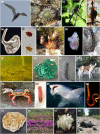The nature of science: The fundamental role of natural history in ecology, evolution, conservation, and education
- PMID: 37877102
- PMCID: PMC10591213
- DOI: 10.1002/ece3.10621
The nature of science: The fundamental role of natural history in ecology, evolution, conservation, and education
Abstract
There is a contemporary trend in many major research institutions to de-emphasize the importance of natural history education in favor of theoretical, laboratory, or simulation-based research programs. This may take the form of removing biodiversity and field courses from the curriculum and the sometimes subtle maligning of natural history research as a "lesser" branch of science. Additional threats include massive funding cuts to natural history museums and the maintenance of their collections, the extirpation of taxonomists across disciplines, and a critical under-appreciation of the role that natural history data (and other forms of observational data, including Indigenous knowledge) play in the scientific process. In this paper, we demonstrate that natural history knowledge is integral to any competitive science program through a comprehensive review of the ways in which they continue to shape modern theory and the public perception of science. We do so by reviewing how natural history research has guided the disciplines of ecology, evolution, and conservation and how natural history data are crucial for effective education programs and public policy. We underscore these insights with contemporary case studies, including: how understanding the dynamics of evolutionary radiation relies on natural history data; methods for extracting novel data from museum specimens; insights provided by multi-decade natural history programs; and how natural history is the most logical venue for creating an informed and scientifically literate society. We conclude with recommendations aimed at students, university faculty, and administrators for integrating and supporting natural history in their mandates. Fundamentally, we are all interested in understanding the natural world, but we can often fall into the habit of abstracting our research away from its natural contexts and complexities. Doing so risks losing sight of entire vistas of new questions and insights in favor of an over-emphasis on simulated or overly controlled studies.
Keywords: biodiversity; conservation biology; earth sciences; equity; museums; policy; science education; taxonomy; undergraduate education.
© 2023 The Authors. Ecology and Evolution published by John Wiley & Sons Ltd.
Conflict of interest statement
The authors declare no competing interests.
Figures


Similar articles
-
Hydroids (Cnidaria, Hydrozoa) from Mauritanian Coral Mounds.Zootaxa. 2020 Nov 16;4878(3):zootaxa.4878.3.2. doi: 10.11646/zootaxa.4878.3.2. Zootaxa. 2020. PMID: 33311142
-
The Global Museum: natural history collections and the future of evolutionary science and public education.PeerJ. 2020 Jan 28;8:e8225. doi: 10.7717/peerj.8225. eCollection 2020. PeerJ. 2020. PMID: 32025365 Free PMC article.
-
Natural history collections as a resource for conservation genomics: Understanding the past to preserve the future.J Hered. 2023 Jun 22;114(4):367-384. doi: 10.1093/jhered/esac066. J Hered. 2023. PMID: 36512345 Review.
-
A conceptual framework for understanding the perspectives on the causes of the science-practice gap in ecology and conservation.Biol Rev Camb Philos Soc. 2018 May;93(2):1032-1055. doi: 10.1111/brv.12385. Epub 2017 Nov 20. Biol Rev Camb Philos Soc. 2018. PMID: 29160024 Review.
-
Student and educator experiences of maternal-child simulation-based learning: a systematic review of qualitative evidence protocol.JBI Database System Rev Implement Rep. 2015 Jan;13(1):14-26. doi: 10.11124/jbisrir-2015-1694. JBI Database System Rev Implement Rep. 2015. PMID: 26447004
Cited by
-
Community science helps digitize 78 years of fish and habitat data for thousands of lakes in Michigan, USA.Sci Data. 2025 Jun 19;12(1):1038. doi: 10.1038/s41597-025-05241-z. Sci Data. 2025. PMID: 40537569 Free PMC article.
-
Protecting hidden treasures: Indigenous lands safeguard 50% of areas with the highest potential for angiosperm discoveries in Brazil-patterns and conservation priorities.PLoS One. 2025 Jul 9;20(7):e0326507. doi: 10.1371/journal.pone.0326507. eCollection 2025. PLoS One. 2025. PMID: 40632702 Free PMC article.
-
Global patterns and drivers of species and genera richness of Fabaceae.Front Plant Sci. 2025 Jul 21;16:1581814. doi: 10.3389/fpls.2025.1581814. eCollection 2025. Front Plant Sci. 2025. PMID: 40761565 Free PMC article.
-
Quantitative Approach for Determining Reproductive Life-History Strategies of Parasitic Plants: A Case Study in Balanophora.Ecol Evol. 2025 Jan 11;15(1):e70746. doi: 10.1002/ece3.70746. eCollection 2025 Jan. Ecol Evol. 2025. PMID: 39803206 Free PMC article.
References
-
- Alroy, J. , Aberhan, M. , Bottjer, D. J. , Foote, M. , Fürsich, F. T. , Harries, P. J. , Hendy, A. J. W. , Holland, S. M. , Ivany, L. C. , Kiessling, W. , Kosnik, M. A. , Marshall, C. R. , McGowan, A. J. , Miller, A. I. , Olszewski, T. D. , Patzkowsky, M. E. , Peters, S. E. , Villier, L. , Wagner, P. J. , … Visaggi, C. C. (2008). Phanerozoic trends in the global diversity of marine invertebrates. Science, 321, 97–100. - PubMed
-
- Andrade, R. O. (2019). Brazil budget cuts threaten 80,000 science scholarships. Nature, 572(7771), 575–576. - PubMed
-
- Andreone, F. , Bartolozzi, L. , Boano, G. , Boano, F. , Bologna, M. A. , Bon, M. , Bressi, N. , Capula, M. , Casale, A. , Casiraghi, M. , Chiozzi, G. , Delfino, M. , Doria, G. , Durante, A. , Ferrari, M. , Gippoliti, S. , Lazinger, M. , Latella, L. , Maio, N. , … Zilli, A. (2014). Italian natural history museums on the verge of collapse? ZooKeys, 416, 139–146. - PMC - PubMed
-
- Andrusak, H. , Matthews, S. , Wilson, A. , Andrusak, G. , Webster, J. , Sebastian, D. , Scholten, G. , Woodruff, P. , Rae, R. , Vidmanic, L. , & Stockner, J. (2006). Okanagan Lake action plan year 10 (2005) report .
Publication types
LinkOut - more resources
Full Text Sources

